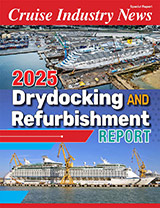According to figures issued today in
The cruise industry is the only area of the tourism sector that is enjoying substantial growth: last year there were some 5.5 million European cruisers (a 10% increase compared to 2009), which works out to approximately 30% of cruise passengers worldwide (18.8 million cruisers). The EU countries with the most cruisers are the
In 2010 the European cruise industry also grew in terms of the numbers of passengers departing from European ports: 5.2 million (+7.2%). The overall (direct and indirect) economic impact of the industry on the continent’s economy last year was 35.2 billion euros, including over 14 billion euros of direct spending. The greatest beneficiaries of this direct expenditure were
“Despite the fact that the economic situation is not the most favorable, European cruising remains a growth industry and continues to play a key role in terms of the creation of wealth and employment. Costa Crociere S.p.A. is the no.1 operator and the driving force in Europe: in 2010 the Group’s ships carried over 2 million Guests and generated an economic impact (direct and indirect spending) worth 2.2 billion euros in
In this context the Costa Crociere S.p.A. Group – comprising the historic Costa Cruises trademark (www.costacruise.com), the number one cruise company for the German market Aida Cruises (www.aida.de), and Iberocruceros (www.iberocruceros.com), which operates mainly for the Spanish- and Portuguese-speaking markets – has confirmed its leadership in Europe.
The Group’s consolidated revenues rose by about 12% in FY 2010, reaching just under 3 billion euros, while the total number of Guests was 2.15 million, representing an increase of some 18% compared to the previous fiscal year. The increase in revenues reinforces Costa Crociere’s position as
Costa Crociere S.p.A. is one of
The Group is headquartered in
This business output was generated from 3 main sources. The first is direct spending (comprising all of the Group’s direct expenditure, for example: general expenses for supplies; new buildings and fleet maintenance; travel agency commissions; and port services).
The second source consists of payrolls for Costa’s shoreside and shipboard personnel who are Italian citizens or resident in
The economic impact of the Costa Group also contributes very substantially to employment. The MIP investigation measures this contribution as follows: 12,300 jobs, of which 3,600 within the Group and 8,700 generated all the way along the supply chain and including job creation among tourism service providers (based on the FTE – full-time equivalent – calculation method). Total employees of Costa Crociere S.p.A., including all nationalities, are about 24,000.



